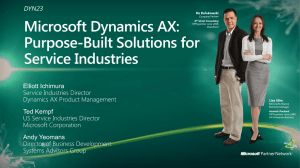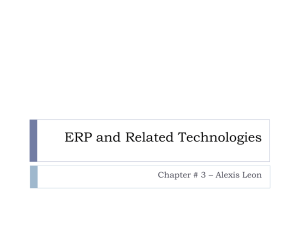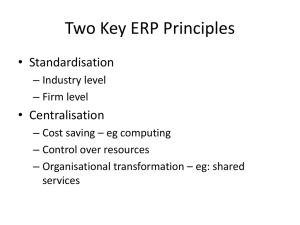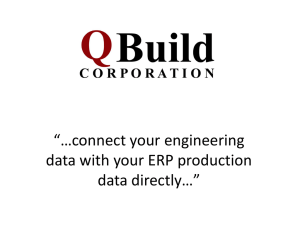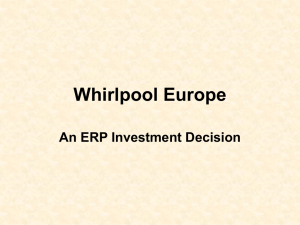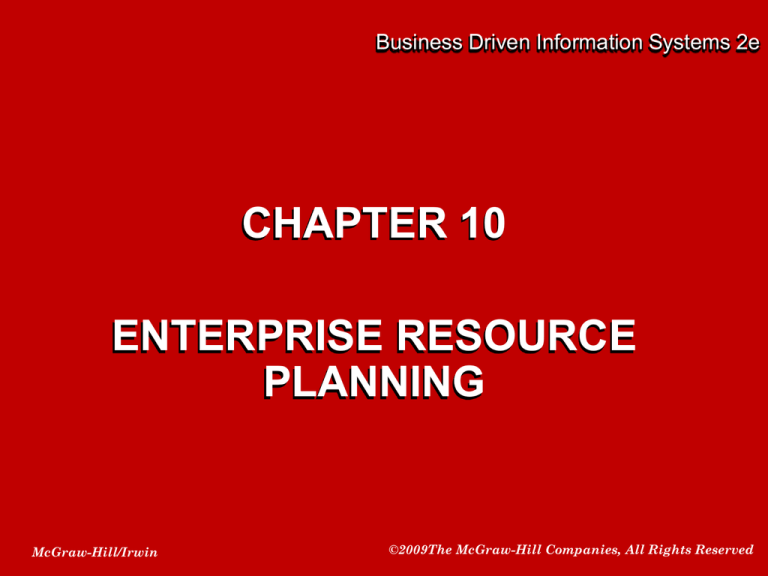
Business Driven Information Systems 2e
CHAPTER 10
ENTERPRISE RESOURCE
PLANNING
McGraw-Hill/Irwin
©2009The McGraw-Hill Companies, All Rights Reserved
10-2
ENTERPRISE RESOURCE
PLANNING
• Enterprise resource planning – integrates all
departments and functions throughout an
organization into a single IT system (or integrated set
of IT systems) so that employees can make
enterprise-wide decisions by viewing enterprise-wide
information on all business operations
– Many organizations fail to maintain consistency across
business operations. If a single dept decides to
implement a new system without considering the other
depts, inconsistencies can occur throughout the
company
– Silos!
10-3
ENTERPRISE RESOURCE
PLANNING
• Reasons ERP systems are powerful tools
– ERP is a logical solution to incompatible applications
– ERP addresses global information sharing and
reporting
– ERP avoids the pain and expense of fixing legacy
systems
• Microsoft Business Solutions–Axapta helped Giant
Bicycle USA link four factories and 12 distribution centers,
and provided immediate information to their customer
service people.
http://www.microsoft.com/dynamics/ax/product/giantbicycl
e.mspx
10-4
ENTERPRISE RESOURCE
PLANNING
• Sample data from a sales database
10-5
ENTERPRISE RESOURCE
PLANNING
• Sample data from an accounting database
10-6
ENTERPRISE RESOURCE
PLANNING
• Why is correlating these two spreadsheets difficult?
– How can you understand customers when one spreadsheet
has customer name and one has customer ID?
– How can you understand sales reps when one spreadsheet
has sales rep names and one spreadsheet has sales rep ID?
– Date format is different – will this cause problems?
– One quantity is in units and one quantity has decimal points –
what problems will this cause?
– Unit price and unit cost is rounded to dollars in one
spreadsheet and contains cents in another – what problems
will this cause?
10-7
ENTERPRISE RESOURCE
PLANNING
• ERP systems collect data from across an
organization and correlates the data generating
an enterprise-wide view to help run the business
10-8
ENTERPRISE RESOURCE
PLANNING
• Most organizations require anywhere from 10 to
100 to 1,000 different systems to run their
business
• Finding one system that could meet all the needs
of an entire organization from billing to sales is
almost impossible, “sort of a utopia”
• An organization can purchase an ERP and still
have other applications running parts of its
business (for example, taxation packages) that
are not supported, or not supported well, by the
ERP system
10-9
The Heart of ERP
• At the heart of all ERP systems is a database
10-10
The Heart of ERP
• ERP systems automate business processes
10-11
The Heart of ERP
• ERP systems automate business processes, for example,
order fulfillment
– When a CSR takes an order from a customer, he or she has all the
information necessary to complete the order (the customer’s credit
rating and order history, the company’s inventory levels, and the
delivery schedule)
– Since the company is using an ERP, everyone else in the company
will automatically see the information that the CSR types into the
ERP system
– When one department finishes with the order, it is automatically
routed via the ERP system to the next department
– To determine where an order is at any point in time, a user only
needs to login to the ERP system and track it down
10-12
The Heart of ERP
The organization before ERP
10-13
The Heart of ERP
• Problems that could occur if all departments maintain
their own database and systems
–
–
–
–
–
Update issues
Redundancy
Inaccurate information across databases
Different formats of information in the different databases
Inability to access other department information and not
being provided with a 360 degree view of the organization
– Different customer information in different databases
– Customer contact from multiple departments with different
messages
10-14
The Heart of ERP
• In most organizations, information has traditionally been
isolated within specific departments, whether on an
individual database, in a file cabinet, or on an employee’s
PC.
• ERP enables employees across the organization to share
information across a single, centralized database.
• With extended portal capabilities, an organization can
also involve its suppliers and customers to participate in
the workflow process, allowing ERP to penetrate the
entire value chain, and help the organization achieve
greater operational efficiency
10-15
The Heart of ERP
• ERP – bringing the organization together
10-16
The Heart of ERP
• Issues that could be caused by having one
database that supports the entire organization
– Not as flexible and far more difficult to change
– Might not meet all department needs as well
as an individual specific system
– Multiple access levels increases security
issues
– Ethical dilemmas from accessing different
department information – such as payroll
10-17
The Heart of ERP
– Digital dashboards offer an effective and
efficient way to view enterprise-wide
information at near real-time.
– According to Nucleus Research, there is a
direct correlation between use of digital
dashboards and a company’s’ return on
investment (ROI), hence all executives should
be using or pushing the development of digital
dashboards to monitor and analyze
organizational operations.
10-18
Turner Industries
• Turner Industries grew from $300 million in sales
to $800 million in sales in less than 10 years
thanks to the implementation of an ERP system.
– Ranked number 369 on the Forbes 500 list of
privately held companies, it is a leading
industrial services firm.
– It develops and deploys advanced software
applications designed to maximize the
productivity of its 25,000 employees and
construction equipment valued at more than
$100 million.
10-19
Turner Industries
– The company considers the biggest challenge
in its industry to be completing projects on
time, within budget while meeting customer
expectations
– It’s ERP system runs all of Turner’s
construction, turnaround, shutdown and
maintenance projects and helps achieve higher
profit margins
– The company passes on the cost savings to its
customers giving it an incredible competitive
advantage
10-20
The Evolution of ERP
10-21
Core and Extended ERP
Components
• Core ERP component – traditional
components included in most ERP systems and
they primarily focus on internal operations
• Extended ERP component – extra
components that meet the organizational needs
not covered by the core components and
primarily focus on external operations
10-22
Core and Extended ERP
Components
10-23
CORE ERP COMPONENTS
•
Three most common core ERP
components
1. Accounting and finance
2. Production and materials management
3. Human resource
10-24
Accounting and Finance ERP
Components
• Accounting and finance ERP
component – manages accounting data
and financial processes within the
enterprise with functions such as general
ledger, accounts payable, accounts
receivable, budgeting, and asset
management
10-25
Accounting and Finance ERP
Components
• Deeley Harley-Davidson Canada (DHDC), has improved
inventory, turnaround time, margins, and customer
satisfaction—all with the implementation of a financial ERP
system.
– The system has opened up the power of information to the
company and is helping it make strategic decisions when it still
has the time to change things.
– The ERP system provides the company with ways to manage
inventory, turnaround time, and utilize warehouse space more
effectively.
– Credit-management feature set limits on how much a customer
can owe at any time
– Product profitability analysis feature allows companies to
perform all types of advanced profitability modeling techniques
10-26
Production and Materials
Management ERP Components
• Production and
materials
management ERP
component – handles
the various aspects of
production planning and
execution such as
demand forecasting,
production scheduling,
job cost accounting,
and quality control
10-27
Production and Materials
Management ERP Components
• Grupo Farmanova Intermed, located in Costa Rica, is a
pharmaceutical marketing and distribution company that
markets nearly 2,500 products to approximately 500
customers in Central and South America.
• The company identified a need for software that could unify
product logistics management in a single country.
– It decided to deploy PeopleSoft financial and distribution ERP
components allowing the company to improve customer data
management, increase confidence among internal and
external users, and coordinate the logistics of inventory.
– With the new PeopleSoft software the company enhanced its
capabilities for handling, distributing, and marketing its
pharmaceuticals.
10-28
Human Resource ERP Component
• Human resource ERP component – tracks
employee information including payroll, benefits,
compensation, performance assessment, and
assumes compliance with the legal requirements
of multiple jurisdictions and tax authorities
– Provides the ability to perform a detailed employee
analysis to discover who is likely to leave the company
unless additional compensation or benefits are
provided
– Can also identify employee resource utilization such
as employee long distance bills and online training
10-29
EXTENDED ERP COMPONENTS
• Extended ERP components include:
– Business intelligence – describes information that
people use to support their decision-making efforts
– Customer relationship management – involves
managing all aspects of a customer’s relationships
with an organization to increase customer loyalty and
retention and an organization's profitability
– Supply chain management – involves the
management of information flows between and
among stages in a supply chain to maximize total
supply chain effectiveness and profitability
10-30
EXTENDED ERP COMPONENTS
– Ebusiness – means conducting business on the
Internet, not only buying and selling, but also serving
customers and collaborating with business partners
• The original focus of ERP systems was the internal
organization. In other words, ERP systems are not
fundamentally ready for the external world of e-business
• The newest extended ERP components are
– Elogistics – manages the transportation and
storage of goods
– Eprocurement – the business-to-business (B2B)
purchase and sale of supplies and services over the
Internet
10-31
EXTENDED ERP COMPONENTS
• Ebusiness and ERP complement each other by
allowing companies to establish a web presence
and fulfill orders expeditiously
• Deploying a web presence without integration of the
back-office or ERP system could prevent a company
from processing orders despite sufficient on-hand
inventory
• Customers and suppliers are demanding access to ERP
information such as order status, inventory levels and
invoice reconciliation
• ERP vendors need to build two channels of access –
B2C (customers) andB2B (partners, suppliers,
businesses)
10-32
INTEGRATING SCM, CRM, AND ERP
• SCM, CRM, and ERP are the backbone of
e-business
– ERP vendors carry SCM and CRM
components, but they are usually not as good
as the vendors that specialize in SCM and
CRM components
• Integration of these applications is the key
to success for many companies
• Integration allows the unlocking of
information to make it available to any
user, anywhere, anytime
10-33
INTEGRATING SCM, CRM, AND ERP
SCM and CRM market overviews
10-34
INTEGRATING SCM, CRM, AND ERP
• General audience and purpose of SCM, CRM and ERP
10-35
INTEGRATING SCM, CRM, AND ERP
• Del Monte, the nations largest producer and distributor of
processed fruits, vegetables and tomato products with over
$3 billion in annual sales acquired StarKist, nature’s
Goodness, 9Lives and Kibbles ‘n Bits from the HJ Heinz
Company
• Del Monte needed to migrate multiple platforms and
consolidate applications centrally on a single system
• Del Monte implemented an ERP system to support its
entire US operations – HQ in SF, operations in Pittsburgh
and distribution centers and manufacturing facilities across
the country
• Customers and trading partners are now provided with a
single, consistent and integrated view of the company
10-36
Integration Tools
• Many companies purchase modules from an
ERP vendor, an SCM vendor, and a CRM
vendor and must integrate the different
modules together
– Middleware
– Enterprise application integration (EAI)
middleware
10-37
Integration Tools
• One of the big selling points of an ERP or SCM system can
be the EAI that is offered to easily integrate with other
vendors’ modules
• For example, if a company is looking at purchasing Siebel
CRM and they find out that Siebel has already built many
integrations to PeopleSoft financials, it would be more
inclined to purchase the product
– Middleware – several different types of software which sit in the
middle of and provide connectivity between two or more software
applications
– Enterprise application integration (EAI) middleware – packages
together commonly used functionality which reduced the time
necessary to develop solutions that integrate applications from
multiple vendors
10-38
Integration Tools
• Data points where SCM, CRM, and ERP integrate
10-39
MEASURING ERP SUCCESS
• Companies can not manage what they can not measure
• Metrics must be developed based on the priorities of the
strategic plan
– Rule of thumb – 7 key metrics ±2
• The value of metrics is in their ability to provide a factual
basis for defining:
– Strategic feedback to show the present status of the
organization from many perspectives for decision makers.
– Diagnostic feedback into various processes to guide
improvements on a continuous basis.
– Trends in performance over time as the metrics are tracked.
– Feedback around the measurement methods themselves and
which metrics should be tracked.
– Quantitative inputs to forecasting methods and models for
decision support systems
10-40
MEASURING ERP SUCCESS
• Balanced scorecard – is a management and
measurement system that enables organizations
to clarify their vision and strategy and translate
them into action
– Developed by Drs. Kaplan and Norton in the early
1990’s
– Provides a clear prescription as to what companies
should measure in order to balance the financial
perspective
– Financial measures tell the story of past events
which is inadequate for guiding and evaluating the
journey that information age companies must make
to create future value through investment in
customers, suppliers, employees, processes,
technology and innovation
10-41
MEASURING ERP SUCCESS
• Balanced scorecard views the organization
from four perspectives
• Users should develop metrics, collect data
and analyze their business relative to each
of these
1.
2.
3.
4.
Learning and growth
Internal business process
Customer
Financial
10-42
MEASURING ERP SUCCESS
10-43
CHOOSING ERP SOFTWARE
•
Successful ERP projects share 3 attributes
1. Overall fit
•
This refers to the degree of gaps that exist
between the system and the business
process. A well-fitting ERP has no major
process gaps and very few minor ones
– Off the rack
– Off the rack and tailored to fit
– Custom made
10-44
CHOOSING ERP SOFTWARE
2. Proper business analysis
•
•
•
The best way to determine which fit strategy
is right is to conduct a thorough business
analysis.
Successful companies normally spend up to
10 percent of the project budget on a
business analysis.
A proper analysis must result in a
documented list of the business processes at
work within the company. This will provide a
basic tool that can measure vendor capability.
10-45
CHOOSING ERP SOFTWARE
3. Solid implementation plans
• As with the installation of any successful process or
machinery, a plan is needed to monitor the quality,
objectives, and timelines.
• A thorough implementation will transfer knowledge to
system users.
• When the project is complete, employees must be
capable of using the tools the new system provides.
• The users must also know what to do in cases when
the process fluctuates. Most failed systems result from
poor quality implementation. ERP is simply a tool
• Tools that people do not know how to use can be as
useless as having no tools at all




